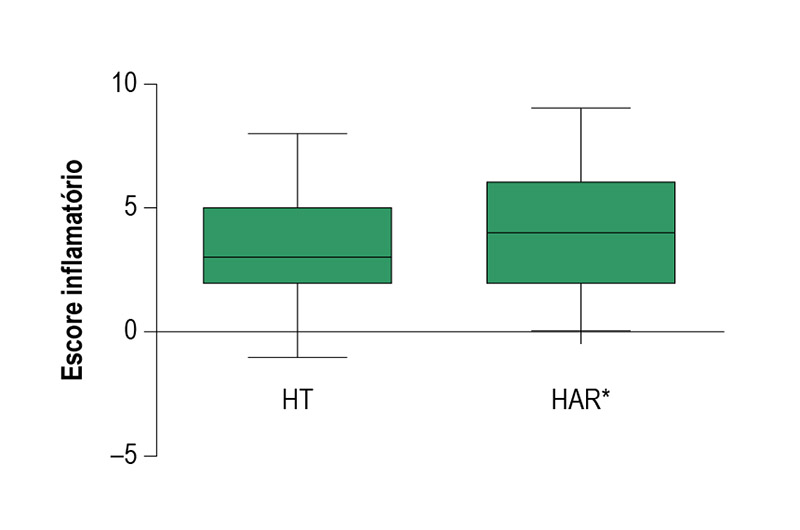Volume 112, Nº 4, April 2019
DOI: http://www.dx.doi.org/10.5935/abc.20190032
ORIGINAL ARTICLE
A Proposed Inflammatory Score of Circulating Cytokines/Adipokines Associated with Resistant Hypertension, but Dependent on Obesity Parameters
Ana Paula de Faria
Alessandra Mileni Versuti Ritter
Carolina Souza Gasparetti
Nathália Batista Corrêa
Veridiana Brunelli
Aurélio Almeida
Nayara Fraccari Pires
Rodrigo Modolo
Heitor Moreno Junior
Ana Paula de Faria

Figure 1 – Inflammatory score calculated between subjects with mild-to-moderate hypertension (HTN) and resistant hypertension (RHTN) (3 [2-5] vs. 4 [2-6], p = 0.02, respectively). IS of each subject was the sum of each pro-inflammatory cytokine score (TNF-alpha, interleukins (IL) -6, -8, -10) from which the scores of anti-inflammatory cytokines (adiponectin and IL-10) were subtracted; *p < 0.05 vs. HTN
Abstract
Background: There is evidence that subclinical systemic inflammation is present in resistant hypertension (RHTN).
Objective: The aim of the study was to develop an integrated measure of circulating cytokines/adipokines involved in the pathophysiology of RHTN.
Methods: RHTN (n = 112) and mild to moderate hypertensive (HTN) subjects (n=112) were studied in a cross-sectional design. Plasma cytokines/adipokines (TNF-alpha, interleukins [IL]-6, -8, -10, leptin and adiponectin) values were divided into tertiles, to which a score ranging from 1 (lowest tertile) to 3 (highest tertile) was assigned. The inflammatory score (IS) of each subject was the sum of each pro-inflammatory cytokine scores from which anti-inflammatory cytokines (adiponectin and IL-10) scores were subtracted. The level of significance accepted was alpha = 0.05.
Results: IS was higher in RHTN subjects compared with HTN subjects [4 (2-6) vs. 3 (2-5); p = 0.02, respectively]. IS positively correlated with body fat parameters, such as body mass index (r = 0.40; p < 0.001), waist circumference (r = 0.30; p < 0.001) and fat mass assessed by bioelectrical impedance analysis (r = 0.31; p < 0.001) in all hypertensive subjects. Logistic regression analyses revealed that IS was an independent predictor of RHTN (OR = 1.20; p = 0.02), independent of age, gender and race, although it did not remain significant after adjustment for body fat parameters.
Conclusion: A state of subclinical inflammation defined by an IS including TNF-alpha, IL-6, IL-8, IL-10, leptin and adiponectin is associated with obese RHTN. In addition, this score correlates with obesity parameters, independently of hypertensive status. The IS may be used for the evaluation of conditions involving low-grade inflammation, such as obesity-related RHTN. Indeed, it also highlights the strong relationship between obesity and inflammatory process. (Arq Bras Cardiol. 2019; 112(4):383-389)
Keywords: Hypertension/physiopathology; Obesity; Inflammation; Cytokines; Adipokines; Probability; Risk Factors.















